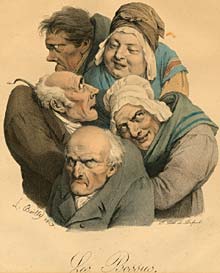French Caricature: Hunchbacks–Mocked or Mocker?
“Les Bossus” or “The Humpbacks” by Boilly is also from “Recueil de grimaces.” Depicted in art for millennia as evidenced by numerous ancient Greek statues, hunchbacks have been treated as outsiders and stigmatized as vile and base. Artists, fascinated by the grotesque, used hunchbacks to symbolize lower and lower-middle classes during the French Restoration (1814-1830) and beyond.16 In addition to the lithograph by Boilly, two other French prints in this exhibit feature hunchbacks: Pigal’s benefactor in “Mœurs parisiennes” and both figures in the caricature illustrating the proverb that one half of the world makes fun of the other. While the benefactor and one of the women in Boilly’s work look pleasant, the remaining four figures in Boilly’s print and the proverb figures have decidedly mean or sly countenances.
A fictional dwarf hunchback, named Mayeux, became a popular icon after the July Revolution of 1830. He was drawn by numerous artists, including Grandville, appeared in hundreds of lithographs, turned up as a character in theatrical productions, and was featured in books and pamphlets.17 Mayeux may have been an inspiration for Quasimodo, the deformed hunchback in Victor Hugo’s “Notre-Dame de Paris.”
Two common causes today of hunchback, or kyphosis, are osteoporosis and arthritis, but these tend to affect the elderly while most of the hunchbacks in this exhibit seem middle aged.18 At the time these lithographs were created, polio and tuberculosis, which starts in the lungs but can disseminate to other parts of the body including the vertebrae, were probably more important factors than degenerative disease in kyphosis. This may help explain why images of hunchbacks are so prevalent in early nineteenth-century art and literature. Not only were they a convenient type of both “malformed outsiders and mockers of society,” but also hunchbacks would have been more evident in the general populace.19
